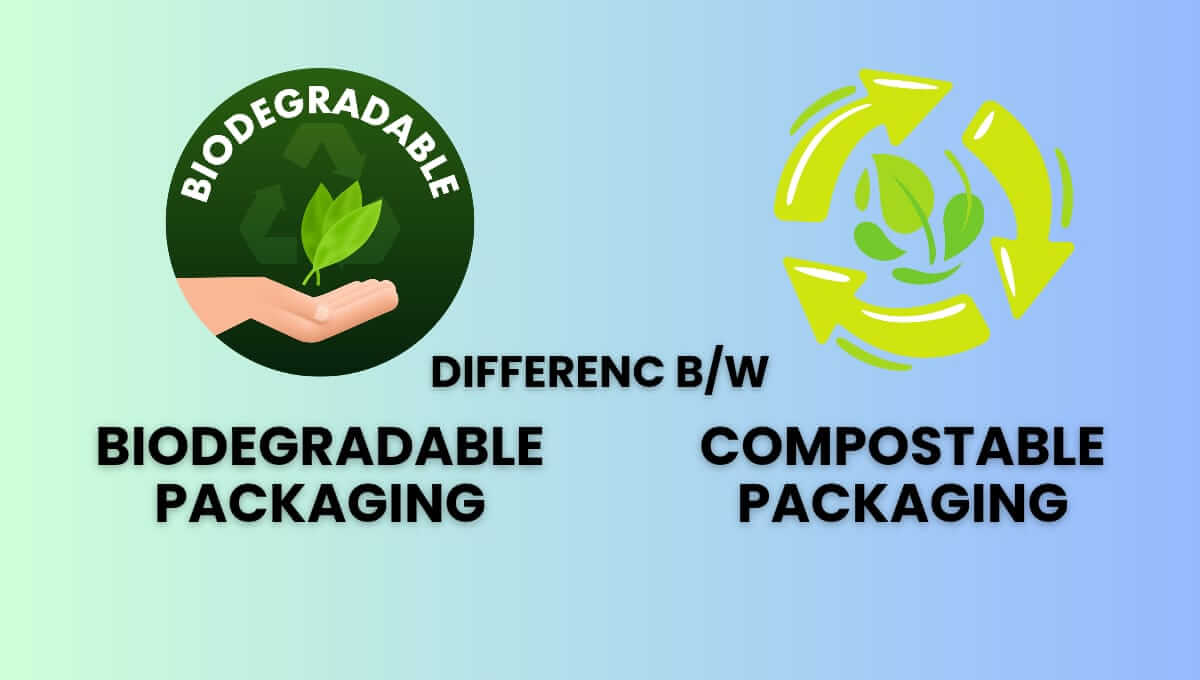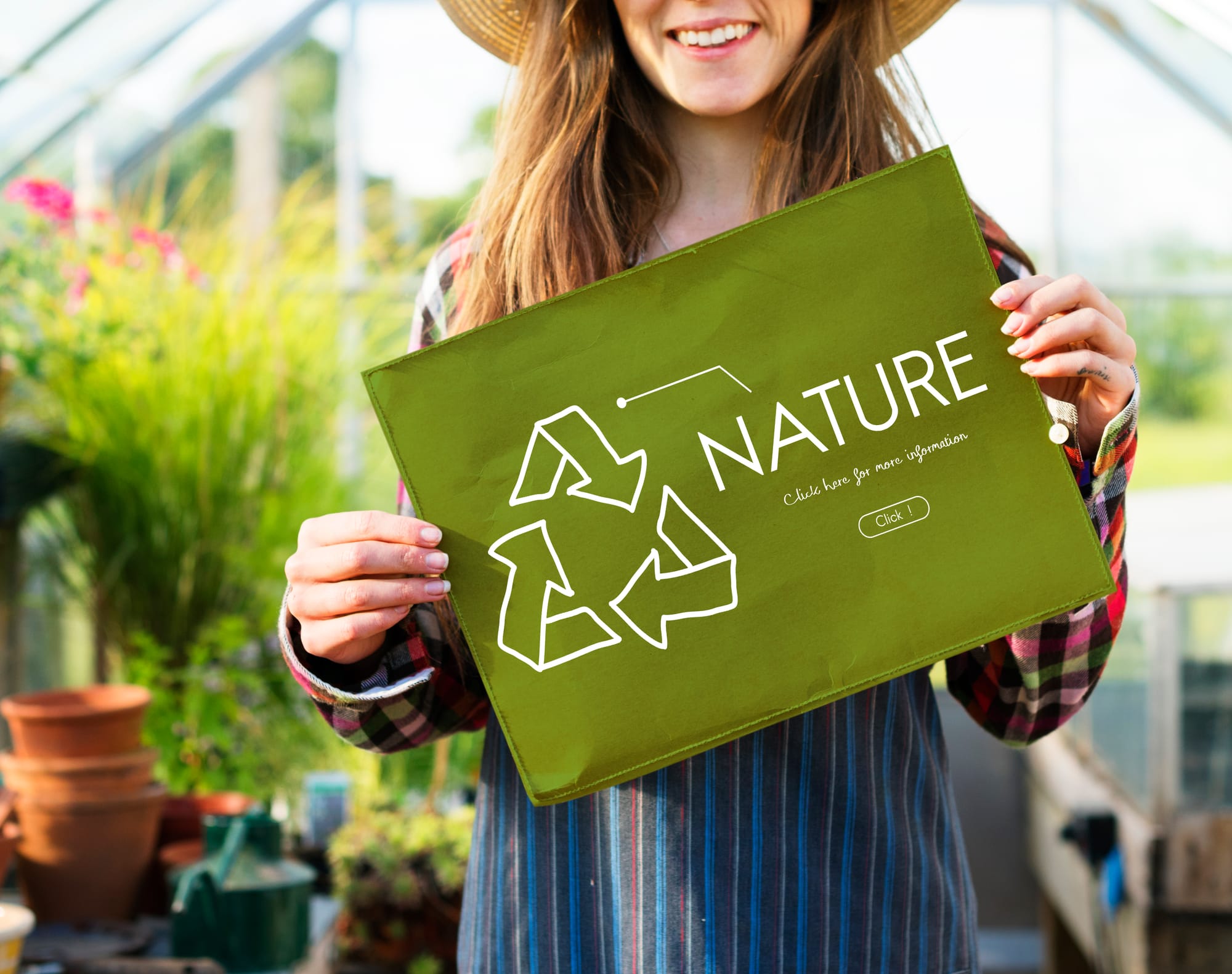Biodegradable vs. Compostable Packaging: What’s the Difference?

Sustainability is the most important aspect of the packaging industry. Customers are becoming more conscious about buying decisions and want to contribute to sustainability.
According to a study, more than 70% of customers willingly pay more if the product packaging is sustainable. That's why brands often look for ways to incorporate sustainability in their packaging.
The most common packaging related to sustainability is biodegradable and compostable packaging. But often, understanding these can be extremely confusing.
That's why this guide will explore biodegradable and compostable packaging in more detail and help you decide which is suitable.
So keep reading.

What Is Biodegradable Packaging?
Biodegradable packaging materials are specifically made to break down into less toxic components with time. The integration process starts because of naturally occurring organic microorganisms and converts them into organic matter. The presence of water is essential for the degradation of biodegradable packaging. It ensures no negative impact on the environment without leaving any toxic chemicals.
But do all compounds break down at the same rate?
No.
The time required for breakdown varies depending on the biodegradable materials and the processing intensity. Generally, the packaging of plant-based and mineral-based products is biodegradable. This packaging can be in the form of:
- Papers
- Boxes
- Bags
- Any objects that are designed to degrade slowly
The integration may take several days, weeks, and sometimes even years. If disposed of correctly, they can reduce the environmental impact. But for proper breakdown of biodegradable materials, some factors play a great role, such as:
- Light
- Moisture
- Air levels
- Temperature
Pros & Cons Of Biodegradable Packaging
With the increase in greenhouse gas emissions, biodegradable packaging is becoming extremely popular. But like every product, it also has some pros and cons.
Here are some of them to learn more about the biodegradation process and its contribution to reducing plastic waste.
Pros
- Environmentally friendly; reduces waste material in landfills and oceans.
- Lowers carbon footprint during production.
- Decomposes in natural environments without special facilities.
- Less reliance on fossil fuels, often plant-based.
Cons
- No universal certification, leading to greenwashing.
- It can leave microplastics behind.
What Is Compostable Packaging?
If compostable is stated on the packaging, it'll break down into different elements. The common elements include:
- Water
- Carbon dioxide
- Inorganic elements
The notable point is that it doesn't leave any harmful residue. Here's what happens.
Compostable Packaging → Sent to industrial composting facility → In compost pile breaks → Compostable objects give soil nutrients.
However, not all compostable packaging can disintegrate in landfills. Conditions such as temperature, moisture, etc., should be optimal for the packaging to break down properly. So, to break it down and turn it into compost, you need to bring it to a commercial facility or industrial composting center.
However, in some cases, composting can be carried out at home. That's why consumers should check the label and instructions for it.
So, what's the key to managing compostable packaging?
A robust waste management system is essential. It should allow you to separate compostable packaging from other types to maximize its advantages. Typically composting does not contribute to microplastic waste. Compostable materials don't produce harmful gases, and compostable waste improves the environment over time.
Pros and Cons of Compostable Packaging
Compostable packaging is widely used as an eco-friendly alternative to harmful packaging. However, it's important to know its advantages and disadvantages. You should know about the composting process and packaging.
Pros
- Breaks down into non-toxic, nutrient-rich compost.
- Supports soil health and reduces waste.
- Certified with clear industry standards.
- Low environmental impact when composted.
- Enhances brand sustainability image.
Cons
- It won't break down in regular waste or landfills.
- Shorter shelf life compared to traditional packaging.
- Needs specific composting conditions to decompose.
Differences Between Biodegradable vs. compostable Packaging
Now that you know about biodegradable and compostable packaging, let's dive deeper and get a quick overview of their primary differences. It will help you get clarity on various types of sustainable packaging options.
|
Aspect |
Biodegradable Packaging |
Compostable Packaging |
|
Definition |
Breaks down naturally over time through biological processes. |
Breaks down into non-toxic components under specific composting conditions. |
|
Decomposition Process |
Decomposes in natural environments (landfills, oceans, etc.). |
Requires a composting environment (industrial or home compost). |
|
Environmental Conditions |
Decomposes in a range of natural conditions but may leave microplastics behind. |
Requires specific conditions such as heat, moisture, and microorganisms to break down fully. |
|
Certification |
No universal certification; may not have clear guidelines. |
It requires certification (e.g., ASTM D6868, EN 13432) to be labeled compostable. Claims to confirm conversion into usable compost. |
|
Disposal |
It can be disposed of in regular waste but may not fully degrade in landfills. |
Must be disposed of in a composting facility or home compost to break down fully. |
|
Environmental Impact |
They are less harmful than traditional plastics but may still contribute to pollution. |
It has a lower environmental impact and contributes to soil enrichment. |
|
Material Examples |
Some plastics, paper, wood, certain plant-based materials. |
PLA (polylactic acid), starch-based materials, and certain plant fibers. |
Factors To Consider When Choosing Between Biodegradable Packaging & Compostable Packaging
Both packaging options are eco-friendly and considered sustainable alternatives. Transitioning from traditional approaches to these options can help you stand out from the crowd. Sustainable packaging does not leave toxic residue and is harmless to human health.
But which recyclable packaging option is right for you?
Here are the factors you must consider when choosing the ideal product packaging for your packaging items.

Be Clear About The Purpose of Packaging
It is important to consider the purpose before selecting biodegradable and compostable packaging. Every company has a unique vision and mission. If your company prioritizes sustainable and eco-friendly packaging solutions, you should choose compostable packaging.
But why?
Compostable packaging is a safe option compared to biodegradable packaging. If you're packaging food products, there is little to no chance of contamination and toxins.
Opt for biodegradable packaging if you're looking for visually appealing packaging with a long shelf life. So ask yourself, what's the purpose of product packaging?
It will give you clarity on which product packaging you need to choose.
Consider Product Type & Shelf Life
The second aspect you need to consider before choosing packaging is its shelf life. The shelf life of biodegradable packaging is much longer than that of compostable packaging. But is there any specific reason behind this?
Yes.
Compostable packaging is made specifically to be broken down easily. It is usually used for organic waste, which is later transformed into compost for nutrient-rich soil.
You should also consider your product type before making a decision.
Biodegradable packaging shelf life is long and its not easily breakable. Due to its strong material, it can be sustained for a longer period of time. You can use it for several products, some of which are below.
- Electronics
- Packaging
- Plastics
List Down All Disposal Options
Now, let's look at the most important part: the end-of-life options. Before selecting any packaging, you should know about all the sustainable options accessible to consumers.
Compostable and biodegradable packaging offers several environmentally friendly disposal options. But which one wins in this category?
Compostable packaging is a much better option. It is made from natural materials, breaks down easily, and provides nutrients to plants.
But as you already know, biodegradable packaging doesn't break down easily. Some are designed carefully so that they can only be broken down through a specific method, and other disposal methods may not be effective for such packaging.
Check Your Budget & Availability
You need to know about the cost of packaging. If you're considering compostable packaging, remember it's made from organic materials. Furthermore, it's designed intricately to break down in soil and provide nutrients. That's why compostable packaging is costly.
You need to source the components and process the organic matter for manufacturing.
But what about biodegradable packaging? Is it also extremely expensive?
First, you need to understand that biodegradable packaging can be manufactured from several materials, including organic or synthetic. It doesn't break down easily, even when exposed to natural elements, which is why it is less expensive than compostable packaging.
To Sum Up
Every business owner wants to choose the best packaging option for their business. To make this decision, you must consider ease of use and other factors mentioned in the article.
Include your environmental sustainability efforts in the marketing material. This will allow you to attract the attention of eco-conscious customers. Trends are changing, and innovations alone are no longer enough to win the hearts of your customers. Combine innovations with environmentally friendly practices to gain a competitive edge.
If you want to learn more about sustainable packaging and labels, check out our detailed guide here. Experts have written these to help you adopt environment-friendly approaches in your business.
Do you want to learn more about it and implement these practices in your business?
Then get in touch with us today. Altro Labels has a team of experts who can take your product packaging to the next level. Check out our incredible client success stories here.
